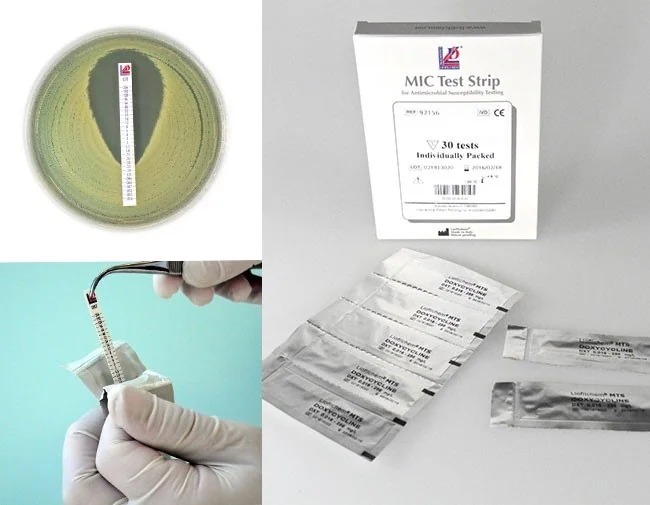Liofilchem™ MTS™ Amphotericin B (AMB) MIC Test Strips (0.002–32 µg/mL)
Catalog No :
CAS Number :
Brand :
In Stock
Specifications:
| Application | Antimicrobial Susceptibility and Resistance Testing (AST) |
| Storage Temperature | -20°C |
| Product Type | MIC Strips |
| Product Brand | Liofilchem |
| Product Grade | Microbiology grade |
Liofilchem™ MTS™ Amphotericin B (AMB) MIC Test Strips are advanced tools for antifungal susceptibility testing. These strips facilitate the quantitative determination of the minimum inhibitory concentration (MIC) of Amphotericin B against a wide range of fungal pathogens, such as Candida spp., Aspergillus spp., and other clinically relevant fungi. The MIC Test Strips provide a gradient of Amphotericin B concentrations ranging from 0.002 to 32 µg/mL, allowing precise evaluation of fungal susceptibility.
Key Features:
- Quantitative MIC Determination: Provides precise MIC values for Amphotericin B within a defined range of concentrations.
- Antifungal Susceptibility Testing: Designed to test susceptibility of fungi, including Candida, Aspergillus, and other yeast and mold species.
- Standardized and Reproducible: Compliant with CLSI and EUCAST guidelines, ensuring high reliability and standardization.
- Ease of Use: User-friendly format that integrates seamlessly into routine laboratory workflows.
- Versatile Application: Compatible with a variety of fungal culture media, including Mueller-Hinton agar with glucose and methylene blue.
Method Principle: The MTS™ Amphotericin B strip consists of a thin, inert plastic strip impregnated with a predefined, exponential concentration gradient of Amphotericin B. When placed on an agar surface inoculated with the fungal strain, the drug diffuses into the medium, forming a stable gradient. The interaction between the fungus and Amphotericin B produces an elliptical zone of inhibition, from which the MIC can be read directly where the fungal growth intersects the strip.
Key Applications:
- Determining the susceptibility of fungal pathogens to Amphotericin B.
- Supporting clinical decisions for antifungal therapy in cases of systemic and invasive fungal infections.
- Detecting emerging resistance patterns in yeast and mold pathogens.
- Evaluating antifungal activity in research and diagnostic laboratories.
Preparation and Use:
- Inoculum Preparation:
- Prepare a fungal suspension equivalent to a 0.5 McFarland standard using sterile saline or other appropriate diluents.
- Agar Plate Preparation:
- Use Mueller-Hinton agar supplemented with glucose (2%) and methylene blue (0.5 µg/mL) or any other recommended medium.
- Swab the inoculum evenly across the agar surface.
- Strip Application:
- Place the Amphotericin B MTS™ strip on the agar surface with sterile forceps.
- Ensure even contact between the strip and the agar.
- Incubation:
- Incubate the plate at 35 ± 2°C in a suitable atmosphere (aerobic or with CO₂ enrichment as required) for 24–48 hours, depending on the fungal species.
- MIC Reading:
- Observe the elliptical zone of inhibition. Read the MIC value directly from the strip at the point where the zone edge intersects the strip.
Interpretation:
- Compare the MIC value to established interpretative breakpoints (e.g., CLSI or EUCAST) to determine susceptibility (S), intermediate (I), or resistance (R).
- The MIC range from 0.002 to 32 µg/mL allows for precise identification of susceptible and resistant fungal strains.
Quality Control:
- Routine quality control should include recommended QC strains, such as Candida parapsilosis ATCC® 22019 and Candida krusei ATCC® 6258.
- Ensure proper calibration and adherence to protocol for consistent results.
Storage and Stability:
- Store at 2–8°C in its original packaging, protected from light and moisture.
- Do not use strips beyond the expiry date printed on the label or if the packaging is damaged.
Shelf Life:
- 24 months from the date of manufacture when stored appropriately.
Advantages:
- Wide Concentration Range: Suitable for both low and high MIC determination.
- Accurate and Reproducible: Enables reproducible results in line with international standards.
- Time-Saving: Simplifies antifungal susceptibility testing with easy-to-read MIC values.
- Cost-Effective: Reduces the need for additional antifungal susceptibility testing methods.
Applications in Clinical and Research Settings:
- Clinical laboratories for routine antifungal susceptibility testing.
- Research facilities studying antifungal agents and resistance mechanisms.
- Epidemiological studies monitoring antifungal resistance trends.
Ordering Information:
- Product: Liofilchem™ MTS™ Amphotericin B (AMB) MIC Test Strips
- Range: 0.002–32 µg/mL
- Packaging: 30 strips per pack
- Catalog Number: [Specific catalog number to be inserted]
Precautions:
- For in vitro diagnostic use only.
- To be used by trained laboratory personnel.
- Handle fungal pathogens with appropriate biosafety precautions.
Liofilchem™ MTS™ Amphotericin B MIC Test Strips offer an advanced and efficient method for antifungal susceptibility testing. Their precision and adherence to global standards make them invaluable tools for managing fungal infections and combating antifungal resistance.
- Pack Size: 100/pk 10/pk 30/pk




 0
0
